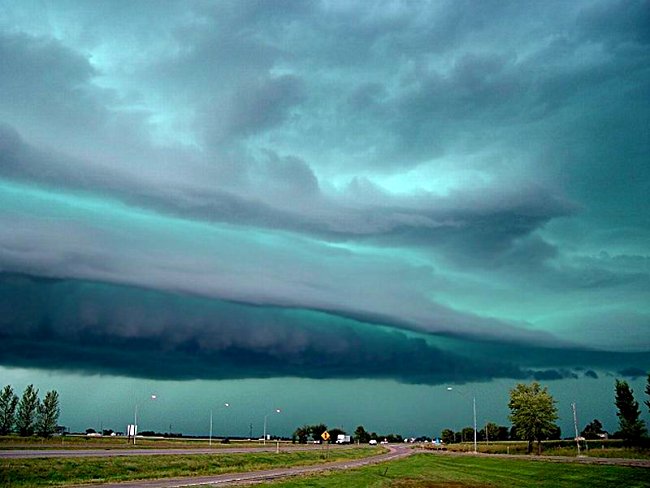- Air Homepage
- Canadian Weather
- Environment Canada Weather Report
Watches, warnings, and more from Environment Canada Weather Reports
Do you need an emergency Environment Canada weather report? Environment Canada has up-to-date forecasts. For instant weather updates, download the WeatherCAN app.
Decoding Environment Canada's life-saving weather alerts ⚠️When severe weather is approaching, do you know the difference between a weather watch, a warning, and an advisory? Learn exactly when to keep your eye on the sky and when to take immediate shelter to protect your family and property, instead of guessing how to prepare.
Find more about Canada Weather.
Find out what Environment Canada's weather alerts mean. Discover how watches and warnings can help you prepare for severe weather. Keep up with potential hazards in your region by finding out which provinces and territories are under alert.
Here's a map that shows which provinces and territories have a current or recent Environment Canada weather warning or watch. You can use this map if you live in or are visiting a particular region to find out if there's severe weather. It's also helpful for people who are planning on traveling soon to know what to expect from the weather.
If your province is red, there's a warning somewhere. A yellow watch means it's current. If it's grey, there was one of either recently, but not anymore.
If you click on an active province, you'll see a couple dozen or so small regions, and only some of them will be colored. Click one to get details. Here's what it says:
- It could be heavy snowfall or wind warnings
- When it was released
- Here are some meteorological and geographical details, and possibly
- Update timeframe.
Discover how thunderstorms and blizzards impact your safety and what precautions to take. Learn how pilots navigate through hazardous weather.
Your Environment Canada weather report has nuance
What's a weather warning from Environment Canada? What's the difference between a watch and a warning? There's something serious happening right now right now or coming up. You can find out if your city, county, or district is affected, but not your exact location. There's a short lead time, sometimes less than an hour.
More specifically...In a weather warning, a government agency or meteorological service warns people about potentially hazardous or dangerous weather conditions that are expected to occur or are already happening.
A weather warning can be issued for a variety of weather conditions, like severe thunderstorms, hurricanes, tornadoes, blizzards, floods, and other weather events that could cause harm to people, animals, or property. People should take precautions and prepare for the weather conditions that may be coming, like staying inside or evacuating an area, securing outdoor items, and having emergency supplies on hand.
Weather watches, on the other hand, are special forecasts in Canada, telling the public that something severe is likely to happen soon. Keep an eye on the radio (?).
More about watches: Weather watches are public notifications issued by governments or meteorological services to warn people about potentially hazardous or dangerous weather conditions.
Conditions are favorable for hazardous weather, but the exact timing, location, and severity are still uncertain. Tornado watches, for instance, mean that atmospheric conditions are favorable for tornadoes to form in a particular area, but it doesn't mean that a tornado has been spotted.
If the weather conditions worsen and a weather warning is issued, people living in the area covered by a weather watch should monitor weather updates. It could mean taking shelter or evacuating, securing outdoor items, or having emergency supplies.
So what's a weather advisory? The weather about to occur is unusual or bothersome, but it's not severe. A big drop in temperature would be an example. It's a public notification from a government agency or meteorological service telling people about weather conditions that could cause inconvenience or be dangerous, but aren't as bad as a weather warning.
There are all kinds of weather conditions that can affect transportation or outdoor activities, such as snow, ice, fog, and wind. For example, a winter weather advisory might be issued if light to moderate snowfall is expected, but not severe enough to warrant a weather warning
The weather advisory doesn't mean there's an immediate threat to life or property, but people living in the affected area should still be aware of the weather conditions and take precautions to keep safe. You may need to adjust your travel plans, wear appropriate clothing, or take steps to protect your pets.
Storm conditions are described in a Special Weather Statement, usually in a marine context. You find out what the weather is going to be like, what the winds will be like, etc. The Special Weather Statement (SWS) is a type of weather advisory issued by meteorological agencies to alert the public to potentially hazardous weather conditions.
A SWS is usually issued for weather conditions that aren't severe enough to warrant an urgent warning, like thunderstorms, heavy rain, snow, fog, or extreme heat or cold. Individuals and communities can take precautions to protect themselves and their property when they get advance notice of potentially hazardous weather conditions.
AIRMETs, SIGMETs, and PIREPs are aviation reports about turbulence, icing, and other stuff. Airmen's Meteorology Reports, or AIRMETs, warn VFR pilots of bad weather. SIGMETs are Significant Meteorology Information. All aircraft get a heads-up on hazardous conditions. Airborne weather observations are described in PIREPs, short for pilot reports.
The SIGMET, PIREP, and AIRMET weather reports are used in aviation to warn pilots about potentially hazardous weather. Meteorological agencies issue SIGMET (Significant Meteorological Information) reports when significant weather conditions may affect flight safety, like severe turbulence, thunderstorms, or icing.
There are SIGMETs that last for up to four hours and cover about 3,000 square miles. Pilots use PIREP (Pilot Report) to report weather conditions like turbulence, icing, and other significant weather conditions that might affect flight safety in flight. Pilots use PIREP to report weather conditions like turbulence, icing, and other significant weather conditions that might affect flight safety in flight.
Pilots get AIRMET reports for less severe weather conditions that can still affect flight safety, like moderate turbulence, low-level wind shear, or icing. There are AIRMETs that last up to six hours and cover a bigger area than SIGMETs.
You can get Canadian aviation weather info on the NAV Canada website. On the weather map page, click the aviation weather link.
Here's your chance to share your thoughts. Put your thoughts down and share them with the world. It could make a difference if you voice your opinion. Make your voice heard! Don't be afraid to speak up!
Experienced the cold?
Everybody knows Canada is cold. Always. What do you think?
This country never has summer. Or does it?
Ever been to Canada? Or some other northern place? Russia? Sweden? Alaska?
Antarctica??
Was it a shock?
Other cold weather examples
Look here to see contributions from other visitors to this page...
Air turbulence flying 



I have been researching the net to find some information but I didn't managed so I decided to write to you. Once I've read in the newspaper about something …
Sprinter Not rated yet
always waiting for spring and praying for an end to winter
Barry's Response - Better than sautumn, for sure. At least you have anticipation rather …
Canada Eh Not rated yet
I live in Canada and it may not be exactly what people think. We have four seasons that are spread out and never fail. Winter, is obviously the coldest …
Cold Weather! Not rated yet
It has been so cold in Canada right now. The coldest day of the winter so far has been -32. There has been a lot more snow too. It has bin a bitter winter …
To recap, SWS aren't as urgent as weather warnings, but they still need attention because they can lead to dangerous conditions if ignored. They help pilots make informed decisions about their flight plans and make the necessary adjustments to avoid hazardous weather.
Search this site for more information now, or go back from Environment Canada Weather Report to the general
Weather Canada web page, or visit the Stuff in the
Air homepage.
The Environment Canada Weather Report - What's in store for you?
Would you like to receive the latest weather report from Environment Canada? Environment Canada provides weather forecasts, watches and warnings, and air quality predictions.
Do you have concerns about air pollution in your area??
Perhaps modelling air pollution will provide the answers to your question.
That is what I do on a full-time basis. Find out if it is necessary for your project.
Have your Say...
on the StuffintheAir facebook page
Other topics listed in these guides:
The Stuff-in-the-Air Site Map
And,
Thank you to my research and writing assistants, ChatGPT and WordTune, as well as Wombo and others for the images.
OpenAI's large-scale language generation model (and others provided by Google and Meta), helped generate this text. As soon as draft language is generated, the author reviews, edits, and revises it to their own liking and is responsible for the content.









New! Comments
Do you like what you see here? Please let us know in the box below.